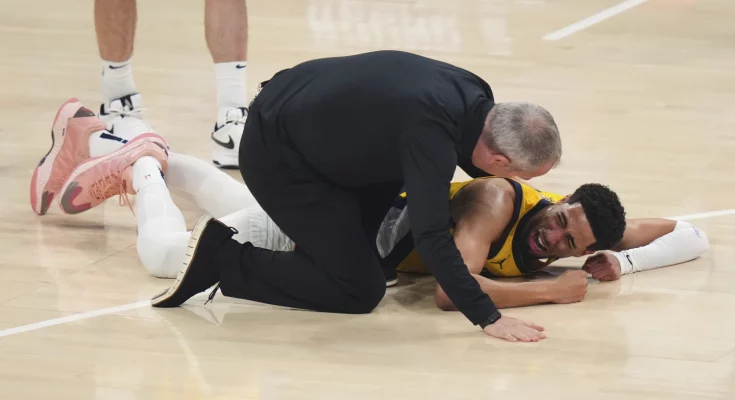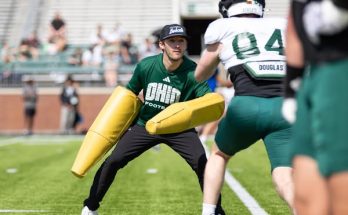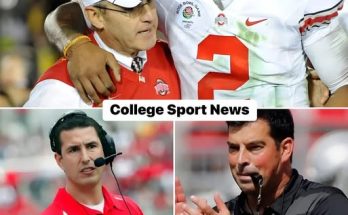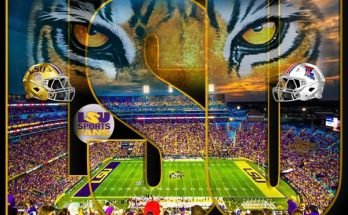In the aftermath of one of the most emotionally charged Game 7s in recent NBA memory, the Indiana Pacers were dealt not just a heartbreaking playoff elimination but also a potentially franchise-altering blow. As the clock wound down in their defeat, all eyes weren’t on the scoreboard but rather on the face of one of the league’s rising stars—Tyrese Haliburton—grimacing in pain and struggling to walk under his own power. What initially seemed like a standard leg injury took a darker, more alarming turn when his father, John Haliburton, told reporters shortly after the game that his son may have suffered an Achilles injury. That one word—Achilles—sent waves of anxiety not just through Pacers fans but across the NBA landscape. For a player of Haliburton’s caliber and age, any injury is concerning, but an Achilles is arguably the most dreaded of them all.
Tyrese Haliburton has steadily grown into one of the league’s most influential young guards. After being traded to Indiana from the Sacramento Kings, he immediately emerged as a cultural and tactical centerpiece of the Pacers’ rebuild. His vision, playmaking, leadership, and feel for the game transformed Indiana from an afterthought into a dangerous Eastern Conference threat. In the 2024–25 season, he averaged 20.1 points, 10.6 assists, and 4 rebounds per game, shooting efficiently from the field while anchoring an offense built around ball movement and dynamic pace. More than just his stats, Haliburton gave Indiana its swagger back. His chemistry with teammates, especially big men like Myles Turner and young wings like Bennedict Mathurin, created a system of organized chaos that opposing defenses had trouble containing.
That’s why Game 7 wasn’t supposed to end like this. For a franchise that has long battled irrelevance since the days of Reggie Miller and the “Malice at the Palace” aftermath, the 2025 playoff run was a breath of fresh air. They fought through adversity, upset more experienced teams, and brought excitement back to Gainbridge Fieldhouse. But against a veteran-laden opponent in Game 7, their fate was sealed not only by scoreboard numbers but by the sight of Haliburton clutching his right leg near the end of the third quarter. He attempted to walk it off, then tried again to re-enter the game. He simply couldn’t. His absence in crunch time was not just a tactical disadvantage; it was a psychological sledgehammer to the rest of the squad.
John Haliburton, never one to speculate lightly, provided the grim revelation that the family and team feared it could be an Achilles injury. Though official confirmation from the team’s medical staff is still pending as of this writing, the mere mention of such an injury has sparked important conversations across basketball circles. Because if it is indeed an Achilles injury, Haliburton’s basketball future—not just the Pacers’ short-term success—becomes a story of careful navigation, recovery, and hopefully redemption.
To understand the full gravity of such an injury, one has to appreciate the biomechanics and importance of the Achilles tendon in basketball. The Achilles connects the calf muscles to the heel bone and is essential for jumping, sprinting, cutting, and virtually every explosive movement an athlete makes. When a player suffers a torn or even partially ruptured Achilles, the consequences are not just painful—they’re often career-altering. The rehabilitation process is long and grueling, typically ranging from 9 to 12 months, depending on the severity of the rupture and the success of surgical intervention.
But more than the timeline, it’s the historical precedent that sends chills. NBA history is filled with stars whose Achilles injuries significantly altered the trajectory of their careers. Think of Kobe Bryant, who ruptured his Achilles at age 34. Though he returned, he was never quite the same physically and retired just a couple of seasons later. Kevin Durant successfully returned from his 2019 Achilles tear, but it took over a year of rehabilitation and even longer to fully regain his elite form. DeMarcus Cousins was another victim—once one of the league’s premier big men, his Achilles injury led to a series of setbacks that turned him from All-Star to journeyman. That’s the daunting club Haliburton may now be joining, though with hope that his youth—at only 25 years old—might allow him a better recovery trajectory.
But let’s not overlook the psychological toll of such an injury either. Players often speak of the fear, frustration, and sense of helplessness during the recovery process. Basketball is not just a job for these athletes; it’s their identity. To suddenly be removed from the court and face months of watching from the sidelines is a mental burden many struggle to cope with. Haliburton, known for his charisma, confidence, and joy for the game, will need to draw deeply from his mental reserves and support system to get through the months ahead—especially if surgery becomes necessary.
Then comes the impact on the team. Indiana was building something special. With Rick Carlisle at the helm and a roster that perfectly complemented Haliburton’s strengths, they were on the verge of becoming a perennial playoff force. The injury throws a massive wrench into those plans. Free agency decisions, rotation evaluations, and development timelines for younger players will all be affected. Without Haliburton running the show, the Pacers are no longer the same high-octane offense. His ability to manipulate defenses, throw no-look dimes, and orchestrate fast breaks is not something easily replicated by a bench replacement or veteran plug-in.
The franchise may now have to consider more strategic depth-building moves. Should they pursue a veteran guard to serve as a stabilizing force during Haliburton’s absence? Could they fast-track the development of second-year prospects or swing for a trade involving someone like Malcolm Brogdon, who could handle primary duties temporarily? Every possibility now carries more urgency, and every decision is shadowed by uncertainty regarding Haliburton’s return window and future explosiveness.
There’s also a broader cautionary tale here about workload and injury management. Haliburton’s regular season saw stretches of heavy usage, and he carried immense responsibility, especially during the playoffs. He logged some of the highest minutes among all guards in the Eastern Conference. The balance between maximizing your star player and preserving their health is an eternal debate in the NBA. Indiana walked that tightrope, and perhaps Game 7 was the moment the rope snapped. It raises vital questions about whether load management—often derided by traditionalists—might be more crucial for preserving young stars in long, grueling seasons.
And let’s not forget how this affects the NBA as a whole. Haliburton is not just an Indiana favorite; he’s one of the league’s most marketable and charismatic young faces. He’s part of the new guard expected to carry the league forward post-LeBron, post-Steph, and post-KD. Alongside the likes of Luka Dončić, Anthony Edwards, Shai Gilgeous-Alexander, and Ja Morant, Haliburton represents the future. His style is fun, inclusive, and highly watchable—he’s the kind of player fans buy jerseys for and kids mimic on the playground. An Achilles injury doesn’t just sideline a player—it silences a voice in the NBA’s cultural and commercial dialogue.
While the official diagnosis is still awaited, fans, analysts, and fellow players have poured in support across social media. Teammates have called him the emotional center of the locker room. Opponents have voiced their respect and hope for a speedy recovery. In an age where rivalries can often turn toxic online, the NBA community seems unified in its concern for Haliburton’s well-being. That, in itself, is a testament to his impact—not just as a player, but as a person.
There is also a medical component to consider for readers unfamiliar with Achilles-related injuries. A ruptured Achilles often presents with a sensation described as being “kicked or shot” in the back of the leg. Sometimes, the tendon can be visibly retracted under the skin. Diagnosis typically involves a Thompson test, where the calf is squeezed and lack of foot movement suggests a rupture. MRI scans are the gold standard to confirm the extent of the damage. Surgery is often followed by extensive physical therapy, starting with gentle range-of-motion work and eventually leading to resistance training and on-court simulation drills. The player must also rebuild trust in the tendon—a subtle but crucial part of the recovery.
Given Haliburton’s work ethic and meticulous approach to his craft, there’s every reason to believe he will attack rehab with vigor. But optimism must be grounded in reality. The return-to-play timeline is never linear. Some days feel like progress; others feel like setbacks. The NBA has become better at supporting athletes through these journeys, offering advanced rehab protocols, sports psychologists, and cutting-edge recovery technology. Still, the road is long.
It is in this crucible of adversity that legends are often forged. Should Haliburton return to form—if he regains his burst, court vision, and creativity—it would be a story of resilience as much as talent. It would inspire not only fans in Indiana but every athlete who’s ever faced a mountain they didn’t choose to climb. The NBA, for all its glamour, is a league of survivors. And if Haliburton is about to embark on that journey, he’ll have a nation of fans watching, hoping, and rooting for the comeback.
For now, Indiana must wait, holding its breath while doctors conduct evaluations, MRIs are analyzed, and decisions are made. The franchise’s future is momentarily frozen, suspended between fear and hope. Tyrese Haliburton, the heartbeat of a reborn Pacers squad, is down but not out. The pain in his right leg may have taken him off the court, but his influence, spirit, and leadership will remain very much alive in Indiana’s locker room—and across the NBA. If this is truly an Achilles injury, it’s the beginning of a new chapter, not the end of the story. And if anyone can write a triumphant one, it’s Haliburton.



